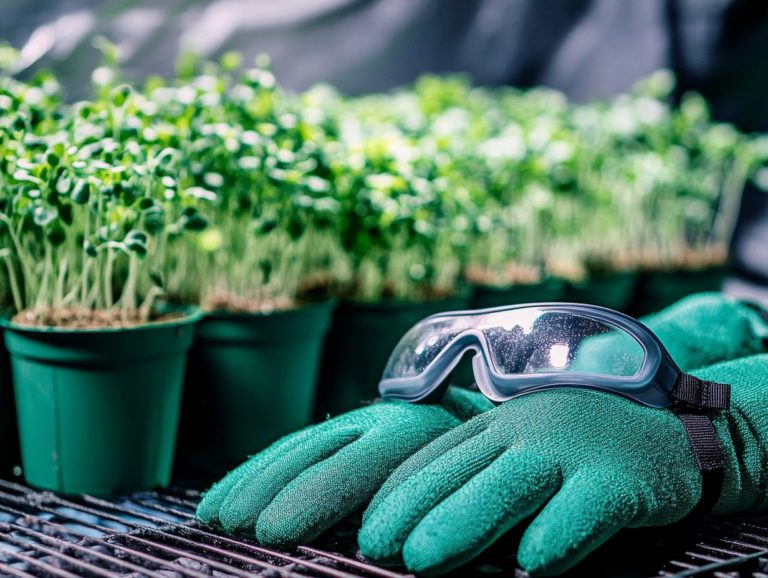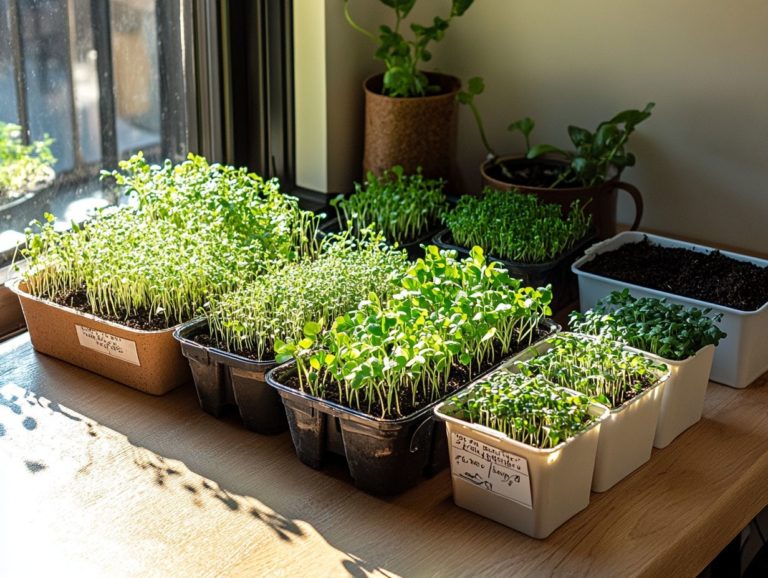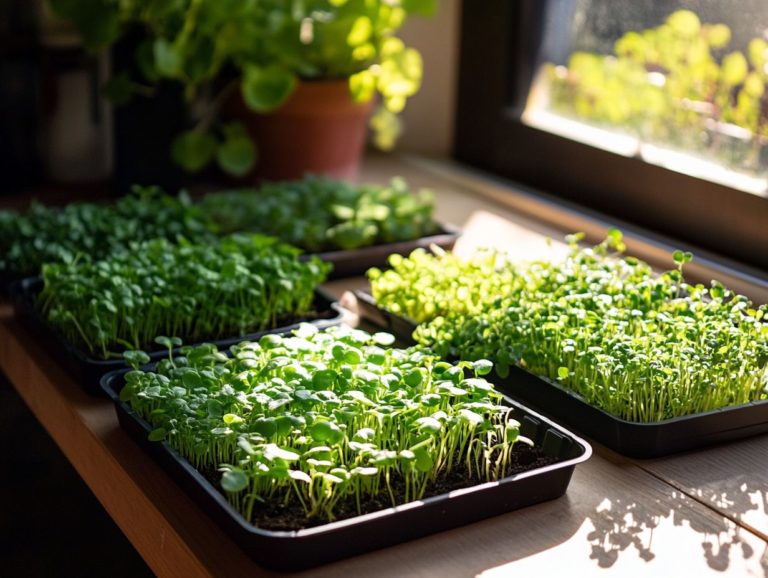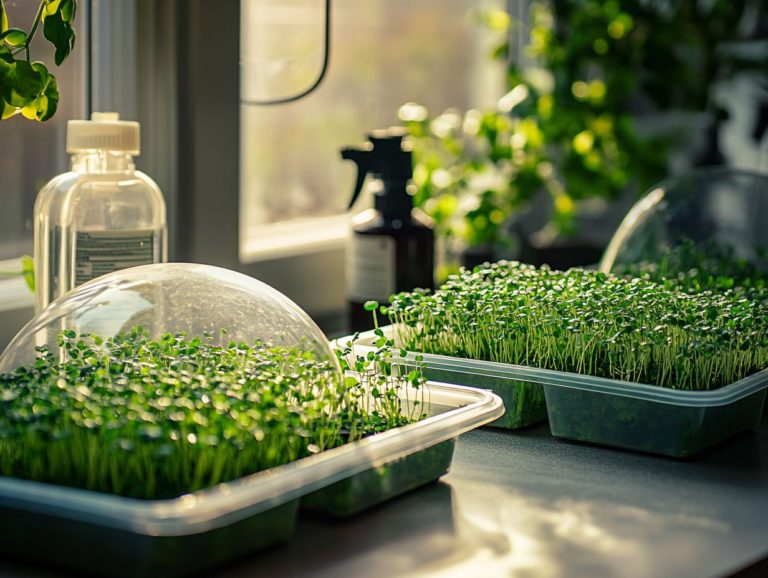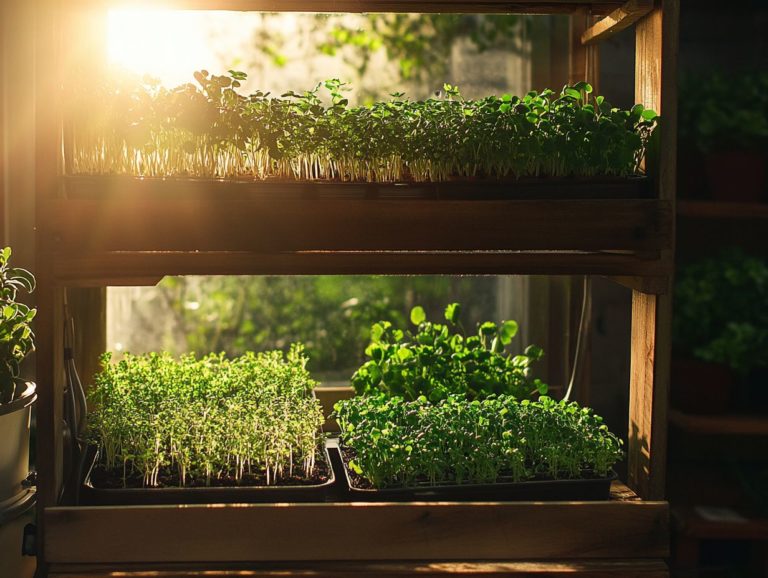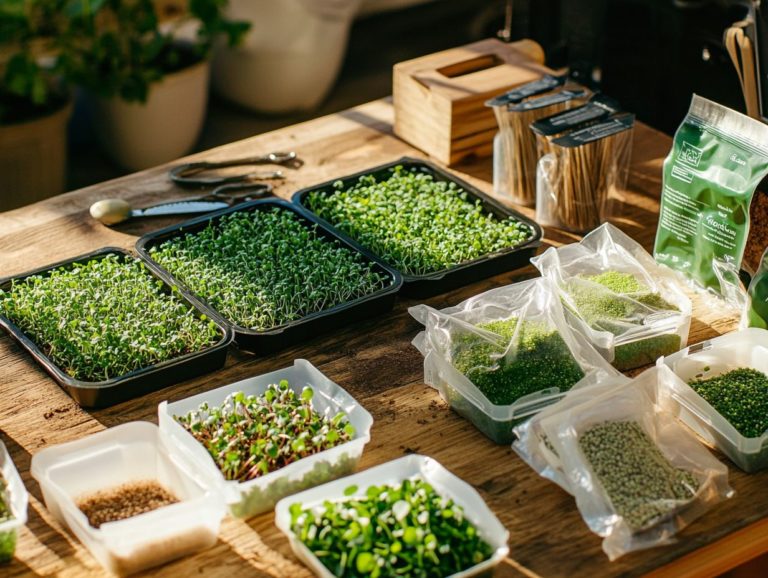The Ultimate Guide to Microgreen Supplies
Microgreens are more than mere trendy garnishes; they are nutrient-dense powerhouses capable of elevating your meals and enhancing your overall health.
Whether you re an experienced gardener or just starting out, understanding microgreens and how to grow them is crucial.
This guide will take you through every step, from selecting the ideal supplies to setting up your growing station.
It will also provide care tips, troubleshoot common issues, and direct you to the best places for supplies.
Are you ready to nurture your green thumb? Let s dive in and get started!
Contents
Key Takeaways:
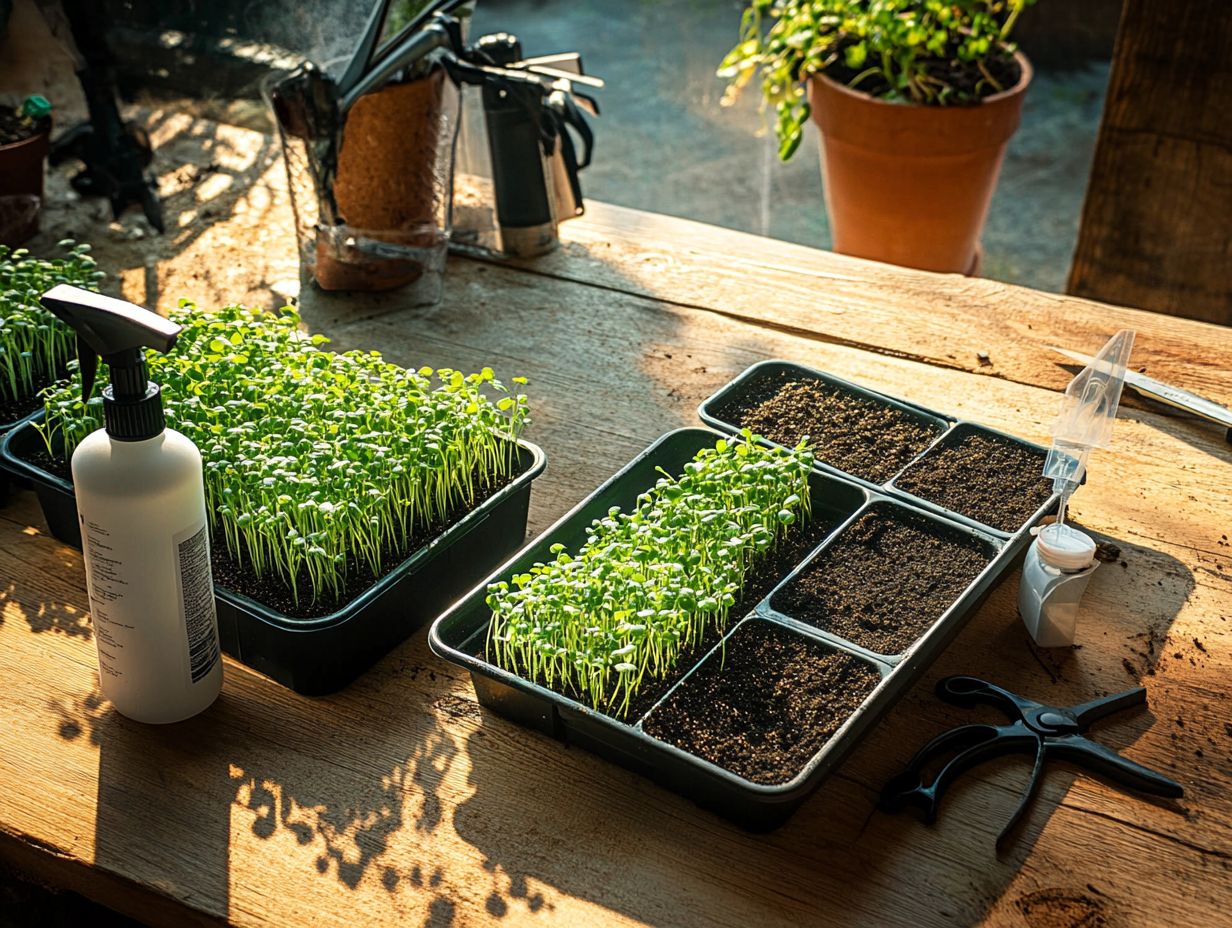
- Microgreens are tiny, nutrient-dense plants that can be grown at home using minimal supplies.
- When choosing microgreen supplies, consider factors such as cost, space, and time commitment.
- The right setup, care, and troubleshooting can ensure successful and efficient growth of microgreens.
What are Microgreens?
Microgreens are young, edible plants that you can harvest early, typically within 7 to 21 days after germination. They are not just small in size; they pack an impressive punch in terms of flavor and nutrition.
These tiny, nutrient-dense vegetables are gaining popularity in home gardening and urban farming, providing a sustainable solution for fresh produce, even in limited spaces. Each variety whether it s arugula, broccoli, or cilantro offers distinct health benefits and can be easily cultivated in various settings.
This makes them an ideal choice for health-conscious individuals looking to enhance their diets with vibrant, fresh options.
Definition and Benefits
Microgreens are the young seedlings of edible vegetables and herbs, brimming with intense flavors and nutritional profiles that can outshine their fully grown counterparts.
These petite greens not only catch the eye but also serve as excellent sources of essential vitamins and minerals. For instance, varieties like radish and kale microgreens are loaded with vitamins A, C, E, and K, contributing to your overall health and vitality. They also contain a rich assortment of minerals such as calcium, magnesium, and potassium, which support strong bones and a healthy cardiovascular system.
Beyond their health benefits, microgreens bring a delightful burst of flavor to your dishes. Basil microgreens deliver a sweet, aromatic taste, while mustard greens add a peppery kick that can elevate any recipe. By incorporating these vibrant greens into your meals, you can effortlessly enhance both flavor and nutritional value.
Choosing the Right Supplies for Microgreens
Selecting the right supplies for growing microgreens is essential for achieving a successful harvest and fostering optimal growth whether you choose traditional soil or a method of growing plants without soil. It all starts with choosing high-quality microgreen seeds, as the germination rate plays a pivotal role in your crop yield and flavor profile.
You ll also want to consider various growing containers and suitable growing media to create the perfect environment for your microgreens. By grasping these fundamentals, you ll be well-equipped to cultivate a thriving microgreen garden in your home or urban farming setup.
Essential Supplies for Growing Microgreens
To successfully grow microgreens, you’ll need a few essential supplies: high-quality microgreen seeds, the right growing containers, and an appropriate soil or hydroponic setup.
Having quality light sources to provide necessary brightness is crucial for optimal growth. Choosing seeds from reputable suppliers sets the stage for robust and healthy plants. Using various growing containers, such as trays or pots, helps manage your space efficiently.
Regarding soil, you have options ranging from nutrient-rich organic blends to coconut coir, each offering unique benefits for microgreens development. If you choose a hydroponic setup, you can use specialized mediums like Rockwool or perlite, which promote excellent drainage and aeration.
Together, these supplies create the ideal environment for your microgreens to truly thrive.
Factors to Consider When Choosing Supplies
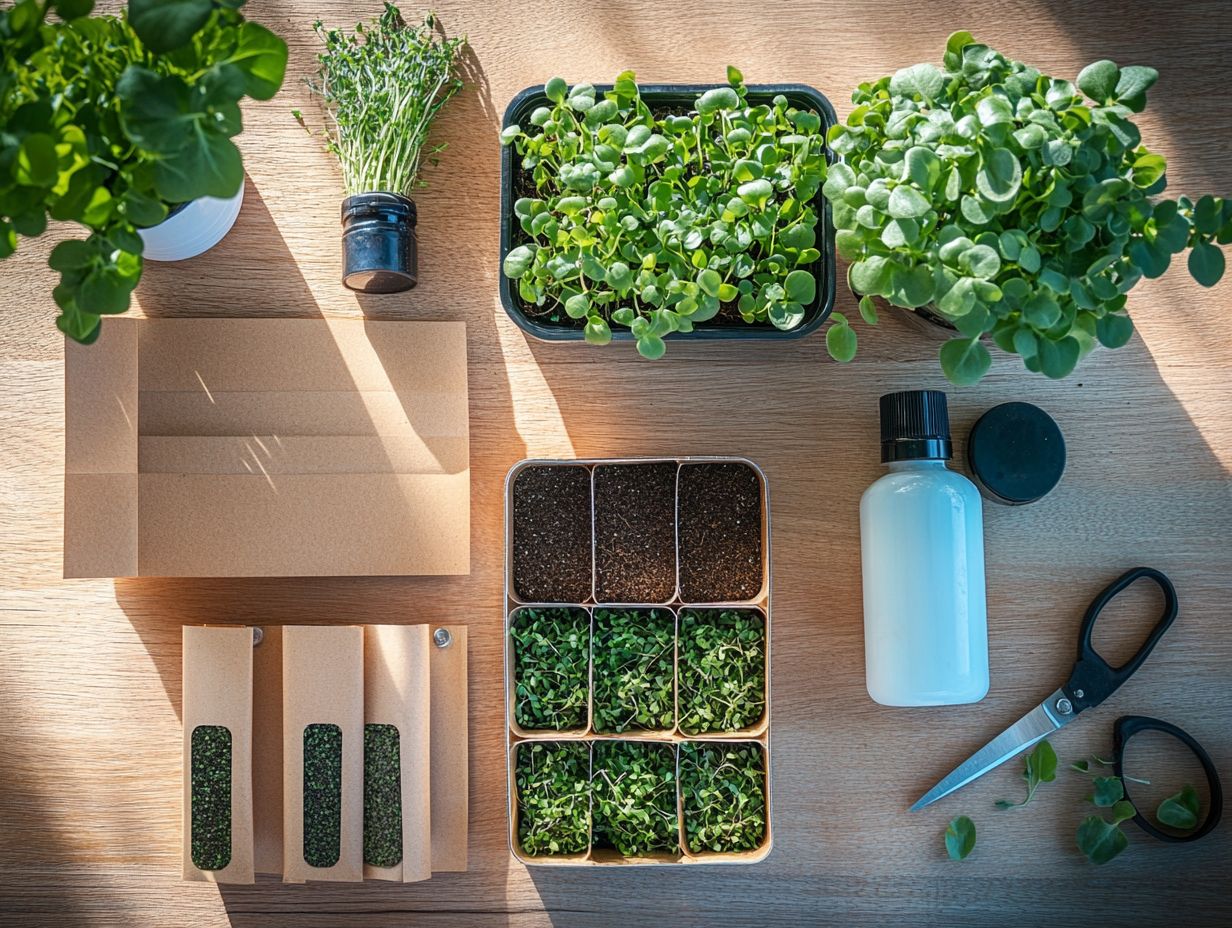
When selecting supplies for growing microgreens, there are several critical factors to consider. The quality of your microgreen seeds and their germination rate are paramount, as they directly impact your harvest success.
Beyond seed quality, the size of the container also plays a significant role in the growth potential of each crop. A larger container allows for greater root development, enhancing nutrient uptake and overall plant health.
The type of growing media you use whether it s soil, coconut coir, or water-based growing systems will dictate moisture retention and drainage. These elements further influence growth rates. Understanding how they interact will improve your yield and ensure that your microgreens reach their full flavor and nutritional potential.
Types of Microgreen Growing Systems
Explore an exciting variety of microgreen growing systems available, tailored to meet your specific needs based on your available space, skill level, and preference for soil or water-based methods.
Soil-based systems use nutrient-rich substrates to nurture the natural growth of microgreens. In contrast, water-based systems create a more controlled environment, often leading to quicker growth rates and increased yields.
By familiarizing yourself with these options, you can select the most suitable method for your microgreen production goals, especially in urban farming scenarios where space is often limited.
Comparison of Different Systems
When comparing soil and water-based growing systems, distinct advantages and challenges arise that could greatly impact your microgreen cultivation success.
Soil-based systems often provide a treasure trove of nutrients, allowing your plants to develop robust flavors and textures. However, these systems might take a bit more time to harvest compared to their water-based counterparts.
On the flip side, water-based systems offer a faster growth rate due to direct delivery of nutrients through water, significantly shortening your cultivation cycle. But be prepared for a more complex setup and continuous monitoring, as maintaining the right pH (a measure of acidity or alkalinity in water) and nutrient levels is essential.
Labor intensity can vary as well. Soil systems might require more hands-on attention with watering and weeding, while water-based systems will challenge you with the need for technical know-how and equipment management. Choose wisely to align with your cultivation goals.
How to Set Up a Microgreen Growing Station
Setting up a microgreen growing station involves a series of precise steps to create the ideal environment for your crops. Start by selecting the right growing containers, preparing either soil or a water-based system, and establishing consistent care routines for watering and lighting.
This guide is designed to walk you through the essential preparations and adjustments needed to foster a thriving microgreen production area in your home or urban garden. By understanding the layout and specific requirements of your growing space, you’ll be well-equipped to maximize both yield and flavor. For the best results, check out the top 7 seed suppliers for microgreens.
Step-by-Step Guide for Setting Up
This step-by-step guide reveals how to set up your microgreen growing station effectively, ensuring you have everything you need for a successful cultivation journey.
- Start with the right growing containers. Choose options that offer good drainage while providing ample space for root development. Consider using trays or pots made from breathable materials to encourage robust growth.
- Choose a nutrient-rich soil mix or hydroponic mat to nourish your tiny plants.
- Once your containers are primed, focus on selecting an optimal location with the right light and temperature conditions for germination. After setting up, plant your chosen microgreen seeds, ensuring to space them appropriately for even growth.
Each of these steps is vital in maximizing the yield and health of your microgreens.
Ready to grow your microgreens? Check out the top 5 microgreen kits for beginners and start your growing station today for vibrant flavors and fresh nutrition!
Look After Microgreens
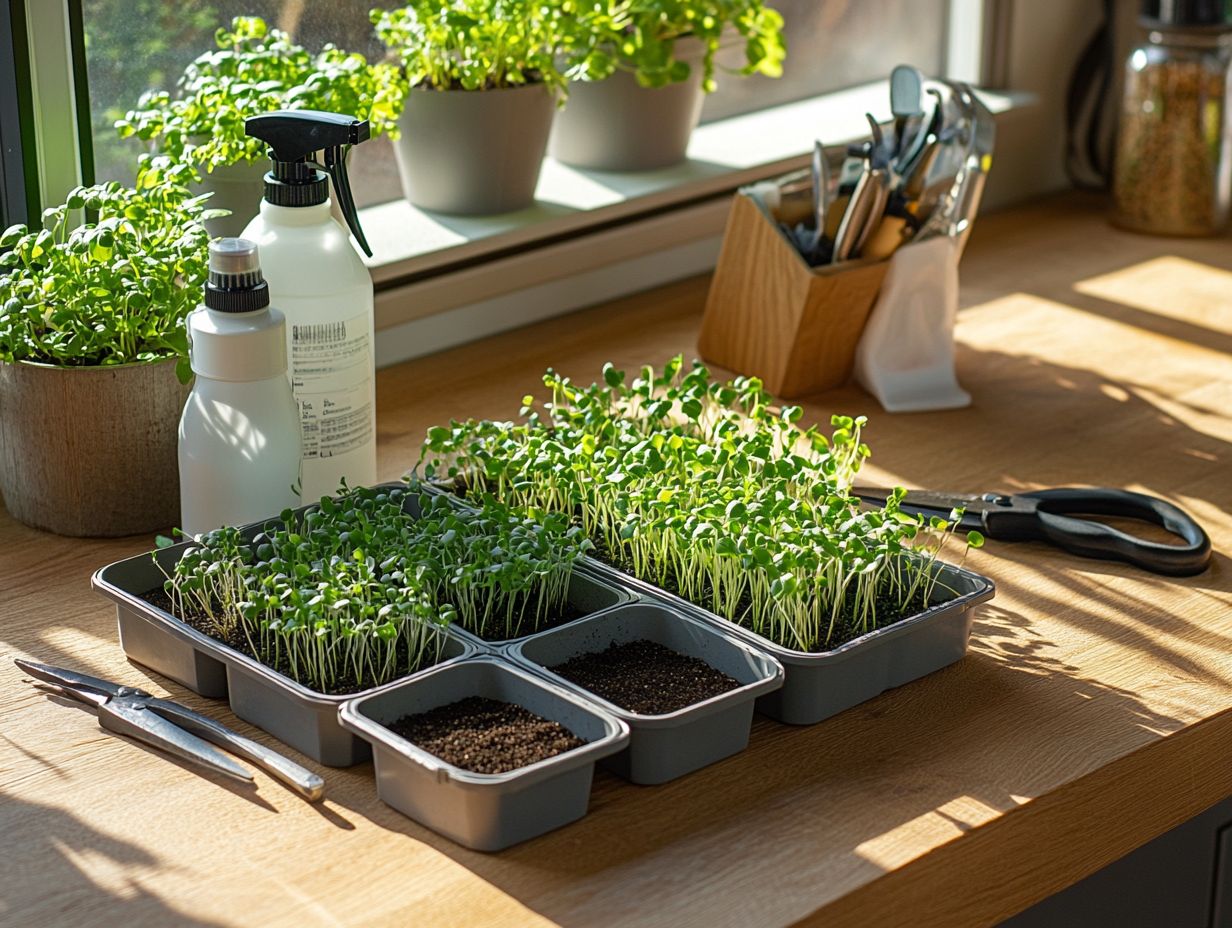
Looking after microgreens requires understanding their specific needs, especially regarding watering, lighting, and harvesting. Each variety has unique requirements, but consistency in moisture and light is critical for optimal growth and flavor.
Implement the right care routines to maximize your yield. You ll be amazed at how much you can grow and the health benefits of your microgreens, making them a prized addition to your home gardening efforts.
Watering, Lighting, and Harvesting Tips
- Watering: Water your microgreens evenly, keeping soil moist but never soggy. A gentle mist from a spray bottle or a careful pour from a watering can works wonders. Just be careful not to disturb those delicate seedlings.
- Lighting: Microgreens thrive under 12-16 hours of bright, indirect sunlight daily. If you lack natural light, use special lights that help plants grow indoors positioned just a few inches above the plants for an extra boost.
- Harvesting: Techniques vary: for leafy greens like mustard or arugula, cut just above the soil line with sharp scissors. For softer varieties like radish, gently tug to avoid damaging the roots. These steps will elevate your microgreens to the next level.
Common Microgreen Problems and How to Fix Them
Common issues in microgreen production can impact growth and yield. By identifying problems early and using effective troubleshooting techniques, you can achieve success in your home garden.
From inadequate lighting to overwatering, recognizing distress signs in your microgreens is crucial. Master the art of resolving these issues promptly to ensure your crops flourish, yielding the nutrient-rich plants you aspire to cultivate.
Identifying and Solving Problems
Addressing common challenges in microgreen production is essential for robust growth and maximizing yields.
You may face hurdles like poor germination rates, often caused by insufficient moisture or incorrect seed depth. If your plants wilt, it could indicate overwatering or inadequate light. Monitor environmental conditions meticulously.
Tackle these issues by using strategies like thorough seed testing and maintaining optimal humidity levels, which means the right amount of moisture in the air. Adjust your watering techniques and utilize grow lights with the right spectrums to enhance plant vitality.
By being aware of these factors, you can address potential problems proactively, nurturing a thriving microgreen environment that leads to a bountiful harvest.
Where to Buy Microgreen Supplies
Finding reliable sources for purchasing microgreen supplies is crucial for cultivating a thriving crop. Whether you need seeds, growing containers, or specialized soil mixes, many suppliers and online stores offer top-notch microgreen products for all gardeners.
By choosing reputable vendors, you guarantee the quality and freshness of your supplies, significantly influencing the success of your microgreen production.
Don t wait! Start caring for your microgreens today for a healthier tomorrow.
Recommended Suppliers and Online Stores
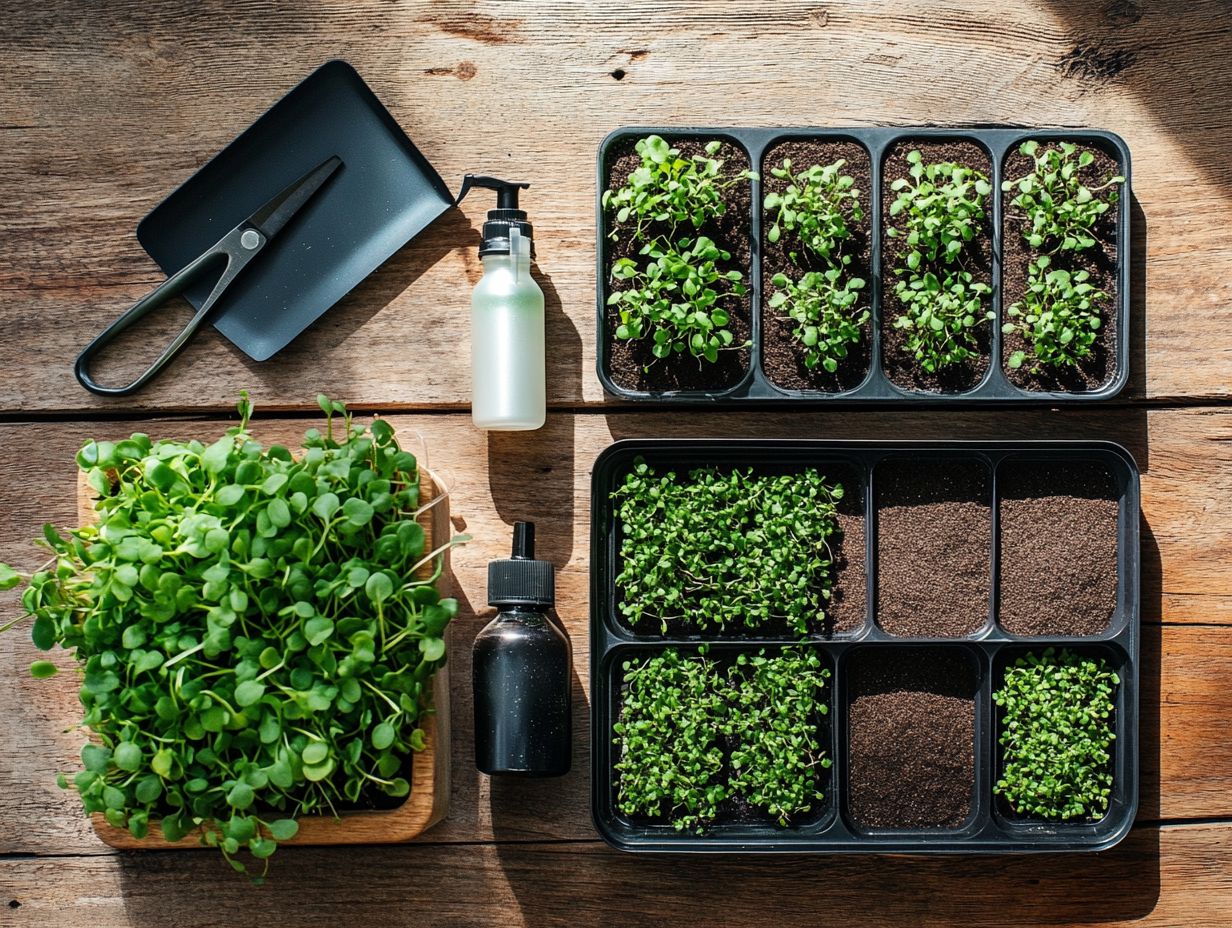
When seeking reliable microgreen supplies, it s wise to consider trusted suppliers that sell good seeds, growing media (the material used to grow plants, like soil or hydroponic systems), and containers. A well-rounded selection can significantly elevate your growing experience.
Several suppliers truly stand out in the industry. Take Johnny s Selected Seeds, for instance; they re renowned for their diverse seed varieties and comprehensive growing guides. Another fantastic option is True Leaf Market, which brings you organic seeds and unique growing kits that have garnered rave reviews for their user-friendliness.
If you re after durable containers and trays, Bootstrap Farmer is highly rated for their sustainability and efficiency in cultivating microgreens. Exploring these sources provides valuable insights into the best practices and products available for both enthusiasts and professionals alike.
Frequently Asked Questions
What is included in the Ultimate Guide to Microgreen Supplies?
The Ultimate Guide to Microgreen Supplies includes a comprehensive list of all the necessary supplies for growing microgreens, along with tips and techniques for successful growth.
What are microgreens?
Microgreens are small, edible greens harvested at the first or second stage of growth. They are packed with nutrients and add a vibrant touch to dishes.
What supplies do I need to grow microgreens?
The supplies needed to grow microgreens include seeds, growing medium, trays, water, and light. This comprehensive guide provides a detailed list of all the necessary items.
Do I need any special equipment to grow microgreens?
No, you do not need any special equipment to grow microgreens. However, having a grow light can significantly enhance their growth and quality.
Can I grow microgreens indoors?
Yes, microgreens can be grown indoors as long as they have access to adequate sunlight or a grow light. This guide also offers tips for growing microgreens in limited space.
What are some benefits of growing microgreens?
Growing microgreens is an affordable and delicious way to add fresh, nutrient-rich greens to your meals. It also allows you to control the quality and safety of your food.
Ready to add fresh greens to your meals? Get started with our guide now!

